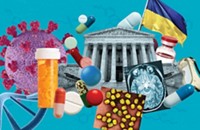Advertisement
Grab your lab coat. Let's get started
Welcome!
Welcome!
Create an account below to get 6 C&EN articles per month, receive newsletters and more - all free.
It seems this is your first time logging in online. Please enter the following information to continue.
As an ACS member you automatically get access to this site. All we need is few more details to create your reading experience.
Not you? Sign in with a different account.
Not you? Sign in with a different account.
ERROR 1
ERROR 1
ERROR 2
ERROR 2
ERROR 2
ERROR 2
ERROR 2
Password and Confirm password must match.
If you have an ACS member number, please enter it here so we can link this account to your membership. (optional)
ERROR 2
ACS values your privacy. By submitting your information, you are gaining access to C&EN and subscribing to our weekly newsletter. We use the information you provide to make your reading experience better, and we will never sell your data to third party members.
Infectious disease
C&EN reflects on what science has learned from COVID-19
by Bibiana Campos-Seijo
January 25, 2021
| A version of this story appeared in
Volume 99, Issue 3

I can’t believe it’s been nearly a year since the World Health Organization (WHO) declared the COVID-19 outbreak a public health emergency of international concern. The declaration, designed to help nations stop the spread of the virus, was made Jan. 30, 2020. To mark the occasion, we are devoting this issue of C&EN to examining what COVID-19 has taught us and how it might affect the way we do science going forward.
On Jan. 10, 2020, the genome for the novel coronavirus was shared. On Feb. 11, the virus was officially named “severe acute respiratory syndrome coronavirus 2,” or SARS-CoV-2, by the International Committee on Taxonomy of Viruses. And a week after that, on Feb. 19, scientists from the University of Texas at Austin and the US National Institutes of Health reported the cryo-electron microscopy (cryo-EM) structure of the spike protein of SARS-CoV-2. And so began a public health roller coaster like the world has not experienced in more than a century.
The ups and downs of the past 12 months have tested our resilience, perseverance, ability to adapt, and capacity to cope with loss. And the loss has been tremendous—first and foremost, the loss of life. But also the loss of jobs and physical connection with friends and family. This month, the number of people who have died from COVID-19 in the US surpassed the number of US military deaths in World War II—more than 400,000.
The pandemic has cost the lives and livelihoods of many in the chemical sciences. In this issue, we honor some of the chemists—friends, mentors, colleagues, volunteers, and American Chemical Society members—who died of COVID-19 (see page 50).
At C&EN we have published hundreds of stories about COVID-19—with many more yet to be written. That coverage reveals that there is light in darkness, and one of those lights is the speed at which doctors and scientists learned about the disease and developed therapeutics and vaccines. Their work has been staggering: one year on and scientists have already developed, manufactured, and started distributing several vaccines to people around the world. From that perspective, 2020 was truly the year of pharma.
Researchers in institutions and corporations everywhere recognized the urgency of the situation and threw everything they could think of at the problem. In this issue we review eight technologies and tools that helped scientists work at never-before-seen speeds to characterize, diagnose, treat, and prevent COVID-19, including adenoviral vectors, CRISPR, cryo-EM, and single-cell genomics (see page 38).
We also examine what we learned from the hundreds of clinical trials attempting to speed the drug development process by repurposing compounds already in our pharmaceutical arsenal (see page 44).
COVID-19 has disrupted the way we live and work. It has certainly changed the culture of science—we examine the good, the bad, and the unknown (see page 30).
The good: the pandemic helped the public better understand science and the scientific process, improved the reputation of the pharmaceutical industry, and put a handful of prominent scientists in the limelight. For researchers, it catalyzed more collaborations and improved the sharing of knowledge and data across disciplines and borders.
The bad: we all lament the pandemic’s worsening of existing inequities, the loss of employment and productivity, and the further politicization of science.
The unknown: there is uncertainty around the future of in-person scientific meetings, remote learning, and the financial stability of academic institutions.
You can also read our analysis of how the COVID-19 pandemic has affected public trust in science (page 18) and view a timeline of efforts to crate a vaccine (page 48).
We remain hopeful about the future and thank scientists for their service.
Views expressed on this page are those of the author and not necessarily those of ACS.





Join the conversation
Contact the reporter
Submit a Letter to the Editor for publication
Engage with us on Twitter